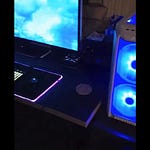Transcript written at PatrickLCheatham.Substack.com, in the publication titled: Renewing & Freshening via Flaw & 'Decayotic'
Music Wording and Production
This podcast series pursues potential new production models and wording terms, in music 'Tonality theory', and in musician and listener 'Impact theory’.More Enjoyable Playback, for when not Producing Music
Producing digital music files via audio workstation on desktop or laptop workstation personal computer, performs well dependent on having a reasonable audio interface peripheral component attached via USB 2.0 connection to the desktop or laptop workstation. USB 3.0+ connection ports can be used amply, as long as 2.0+ is supported, as the data is audio-only, and USB 2.0+ performs well at this.
I’ve personally used several audio interfaces over the years, from brands such as M-AUDIO, Focusrite, PreSonus, and Arturia.
New for me, recently, is usage of Arturia’s Audiofuse audio interface in place of my former Minifuse 4 audio interface, also by Arturia. The former Minifuse 4 performed very well at rendering audio to the mixing boards in my audio workstation software, and it rendered very good quality mixdowns and exports to .wav or .mp3 files. I purchased the Audiofuse for its smaller size and portability, its better layout of headphones jacks and inputs, and to upgrade from the Minifuse 4 in terms of rear panel jack designs, and front panel details more nicely laid out.
In a very nice surprise for me with the new Arturia Audiofuse interface, I discovered what could be a new attention possibly by Arturia hardware designers on playback quality via preamplification qualities enhanced, differing from render, latency, and mixdown export qualities. The Minifuse 4 produced excellent .wav and .mp3 files, but with the Minifuse 4, as with also for years the audio interfaces I used by brands Focusrite, M-AUDIO, and PreSonus, playback quality was seemingly secondary in design to delivering to music producers excellent and maximum rendering qualities for file export. I had not realized this formerly, and upon installing the Audiofuse interface, my M-AUDIO Graphite 5-inch studio monitor speakers began to sound of richer, warmer, and less cold overly-crisp qualities, which I now enjoy much more during playback of mine and other musicians music, than was previously possible with former audio interfaces.
I had not realized that with the audio interfaces I had previously used, I was losing playback preamp performance to attain great rendering of mixdowns. Now, with the Audiofuse by Arturia, I truly enjoy playback and listening on par with decades past high-end stereo rack systems I once formerly had placed in living room spaces. This I dispensed with more than 10 years ago, with all my music listening and playback being performed via computer workstation and in car while driving.
Techniques in Impact Theory, affecting the music composer, and also final composition qualities
More technically, we as musicians typically at some point begin to notice issues of under-saturation and over-saturation in sound qualities of our work, notice of which during composition at audio workstation software can begin a lengthy process which hinges between such as track instrumentation pan width, count of voices, glide and envelope release overlaps with other notes, equalization richness, effects mixing, and overlap of notes between differing tracks, via duplication, or of notes in same track, via chord structures used concurrently. Often, a glad medium is pursued from which sound qualities are neither too thin and under-saturated, nor are they too fat and over-saturated. Chord structures reduction to only one series of notes I typically favor. However, if a song exhibits great counterpoint with very few total tracks, such as 2 to 4 total, including percussion, then there is more medium-range saturation ‘room’ for chord structures, and retaining some extra fatness to only one track, with others thinner and of less saturation, works well for me.
Some techniques if over-saturation is present include reducing chord structures to not concurrently play as many notes in harmony, or reducing delay, reverb, chorus, and other effects to lesser intensities. This proceeds usually better if and when those effects, as initially desired, are adjusted via reductions in parameter intensities, rather than via outright cutting out of the effect(s) totally.
An exception is if very many effects were heavily selected, then narrowing in on one or two desired effects performs well.
Percussion thump with sustaining aftersound is trickier to reduce, and parameters are worth zooming in on or entered into for changes, with much smaller amounts of tweaking in mindset, which is a change of styles in regarding those software knobs, to which we typically attribute larger changes of parameters as being involved, to matter much.
With percussion kick and snare sampled sounds especially, the numerical adjustments become miniscule which attain hugely different results, so a reapproach to fine-tuning of much more precision with the knobs is the only way I’ve been able to adjust drum and percussion samplers to my satisfaction.
Percussion samplers are very reactive to very small changes in parameters, such that the range of parameter differences between sounds becoming too crisp sonically as hard-cutting sounds, and at the other extreme, too much of resonant thumping via uncut sounds overbearing, is a very small range to work within. Very small tweaks, as to parameters, change so very much to the sound qualities, that it becomes worthwhile to briefly become more diligent and tightly focused in between the extremes, with miniscule adjustments in mind as being worth the refined subtlety intensity at focus, briefly.
Saving a large count of preset settings parameter files, to cover ranges of parameters, clutters up the process of re-loading to compare those, with our senses of sound becoming blended with our senses of so very many mouse-clicks in a tiring and distracting manner, so working the tweaks back and forth, up/down or left/right in notion, before settling-in when happy with results, I compose better with. Then, I can switch to other tasks less repetitive and droll, and possibly return at one more instance in a composing session for another go at the same exact process, which is a good maximum for the composer to demand of himself or herself, all at one task.
Switching to other sound design and composition tasks, and staying clear of too much mouse-click saving and re-loading, does retain a more enjoyable cast to the process, and this I know from experience has effects on resulting quality and mood of that which is composed. This also probably has results impacting the sound designs resultant via preset design, though in ways not comparable, but only estimated by each of us as seeming to follow the weary factor versus the inspired and self-entertained factor.
End of narrative, for episode 2.







